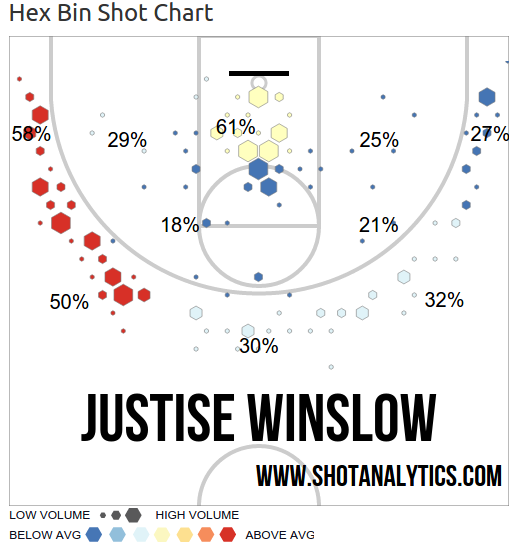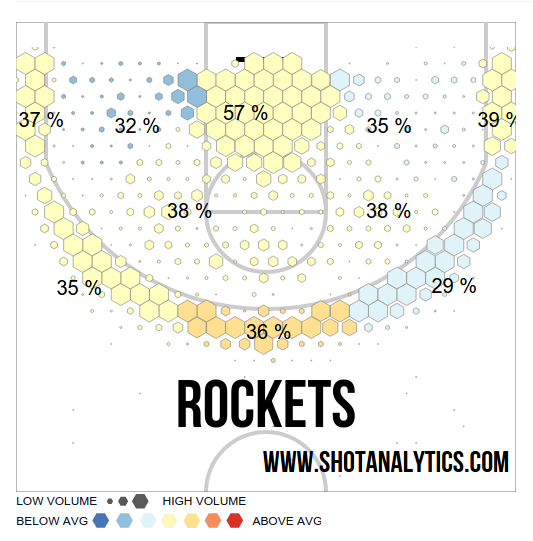Justise Winslow: A Defensive Maverick With Big “O” Questions
Basketball writer Derek Bodner is covering the NBA draft for Philadelphia magazine at Sixers Draftland.
As we wrap up our series of player profiles leading up to Thursday’s NBA draft, we take a look at Duke freshman Justise Winslow.
An incredible defensive player who shot surprisingly well from three-point range — and who has a quick first step that can lead to further offensive potential down the line — few have talked about Winslow as a possibility at No. 3 in the draft.
Is he somebody Sam Hinkie would consider?
Previous profiles:
Key information
Age: 19 years old
Measurements: 6′ 6.5″ (in shoes), 222 pounds, 6′ 10.25″ wingspan, 8′-8.5″ standing reach.
Stats: 12.6 points, 6.5 rebounds, 2.5 assists, and 1.3 steals per game in 29.1 minutes. Shot 48.6% from the field, 41.8% from three-point range.
Advanced stats: 10.4 Boxscore plus/minus (5.1 offensive, 5.3 defensive), 5.5 win shares (3.1 offensive, 2.5 defensive), 0.196 win shares per 40 minutes, 43.8% free throw rate, 57.2% true shooting percentage.
(Quick glossary: Boxscore plus/minus is an estimate of the points a player adds to his team per 100 possessions above the league average. Win shares is an estimate on the number of wins a player added to his team. Win shares/40 minutes is win shares for every 40 minutes of play, with the average being ~0.100/40 minutes. Free throw rate is the number of free throw attempts per field goal attempt, and true shooting percentage is an attempt to “fix” field goal percentage, factoring in the additional value of the three-point shot and a player’s ability to get to the free throw line to paint a more accurate picture of a player’s efficiency).
Chance of being available at No. 3: Very good. There has been almost no talk of Winslow going either first or second.
Why should you be interested?
We’ve seen the Sixers target elite athletes and strong defensive players during the two years since Sam Hinkie took over, and Justise Winslow fits that mold very well.
The interest around Winslow starts with his defense, as he’s one of the best players in the draft in that area. Winslow’s versatility on that end of the court was a huge bonus for Duke, as he has the exceptional lateral foot speed necessary to defend either wing position, but also the strength, toughness and aggressiveness to defend college power forwards.
Measuring only 6′ 6″ in shoes at the NBA Combine, Winslow probably won’t be playing very much power forward in the NBA. But knowing that he has the strength and competitiveness to more than hold his own down low against much bigger competition speaks to his versatility and demeanor on the court.
What’s impressive about Winslow isn’t just his physical tools, but how locked in he is on the defensive side of the court. He’s almost always in good position and in a good defensive stance, with a consistently high level of effort as well. Winslow competes on this end of the court — which, when paired with his excellent physical tools and a willingness to be taught — typically yields great results.
Winslow really showcased his potential as an offensive player in the second half of the season. Winslow’s season hit a low in January, when the freshman averaged only 9.2 points per game and shot just 39.5% from the field. He turned that around in February, averaging 16.3 points per game on 55.6% shooting, then went on to average 14.3 points per game during Duke’s NCAA Championship run.
What fueled the turnaround? One of the changes that is frequently brought up is Duke’s release of Rasheed Sulaimon, who last played on January 28th. The move forced Winslow into being more of a focal point in Duke’s offense, and the changes in his effectiveness were pretty drastic.
| Period | Mins/g | Pts/g | Reb/g | Ast/g | FG% | 3PT% |
|---|---|---|---|---|---|---|
| Before Jan 30th | 27.1 | 10.7 | 4.5 | 1.8 | 42.9% | 37.3% |
| After Jan 30th | 31.3 | 14.7 | 8.6 | 2.4 | 53.7% | 48.8% |
Before Sulaimon’s dismissal, Winslow had just gone through his toughest stretch of the season, averaging only three points per game over a four-game span. After the change, Winslow would go on to average 16.3 points per game over his next three games and reach double figures in scoring in 18 of Duke’s 19 remaining games.
Another big change in Duke’s lineup toward the end of the season was the replacement of Amile Jefferson by Matt Jones in the starting lineup late in February. The change impacted Winslow in multiple ways:
First, it moved Winslow to the power forward spot, where the quickness advantage he had over the man defending him was substantial. Playing the 4 also allowed Winslow to be closer to the basket on defense, which let him make a real impact on the defensive glass. Winslow’s ability to grab a defensive rebound and push the ball in transition helped ignite Duke’s transition offense and showcased a real strength in Winslow’s game. Finally, adding Jones to the starting lineup gave Duke another three-point shooter on the court, something that benefitted both Winslow’s drives to the hoop and Jahlil Okafor‘s post-up game.
The final factor in Winslow’s improved play over the second half of the season was getting healthy. Winslow battled through shoulder and rib injuries early in the season, both of which likely had a substantial impact on his mid-season lull.
Winslow shot extremely well from the perimeter this season to the surprise of some, connecting on 41.8% of his three-point attempts on the season. That three-point shooting, combined with a strong first step and an ability to finish in the paint, forms the basis of his offensive game. Winslow’s strong upper body, good body control and touch around the rim allow him to be very effective scoring in the paint, and he does a good job of drawing contact and getting to the line as well.
Winslow’s also a good passer once he gets into the lane, something that is always a plus for a wing that you hope can develop into a legitimate offensive option on the perimeter.

(Shot chart courtesy of shotanalytics.com)
That shot chart above — with virtually everything either at the rim or from beyond the three-point line — is a statistician’s heaven, as those are the most efficient shots in basketball. It’s a shot chart that shares more than a passing similarity with that of the Houston Rockets (below) — Hinkie’s previous organization — one he’s likely looking to emulate.

(Shot chart courtesy of shotanalytics.com)
Why shouldn’t you be interested?
There are a few holes in Winslow’s game, some of which bring into question just how reasonable it is to expect he can develop into a top offensive option at the next level.
While Winslow shot nearly 42% from three-point range, that being a consistent part of his game, at least at that level of efficiency, isn’t a foregone conclusion. Winslow has a fairly slow and deliberate release, and needs time to get a clean look at the basket. This limits somewhat his impact as a floor spacer: Since defenses have more time to recover back to Winslow they’re more willing to roam off of him to provide help.
There’s also the inconsistency between Winslow’s good three-point shooting (41.8%) and his poor free throw shooting (64.1%). Free throw shooting is usually seen as a good indicator of future success, in large part because there’s usually just a much larger sample size in the number of attempts. One thing that could give scouts hope that his poor free throw shooting at Duke was mostly noise is that Winslow shot the ball well from the foul line in high school, connecting on 80% of his 309 free throw attempts during his senior season. Still, 64.1% from the line for a perimeter player is a definite concern.
Winslow could also struggle to make the jump to the NBA three point line. 52 of his three-point attempts were from 24 feet or more, and he shot only 31% on those attempts. That’s not to say he can’t extend his range out the additional 3 feet with time and practice, but it’s not exactly a guarantee, either, and at the very least there’s a chance for a bit of a regression as Winslow adjusts to the longer distance.
Finally, Winslow’s success as a shooter came almost exclusively from standstill catch and shoot attempts, as he got virtually nothing either coming off of a screen or pulling up off the dribble. In fact, Winslow shot just 10.5% on jump shots off the dribble this past season, connecting on only two all year. While avoiding the midrange game is in theory a benefit, becoming a high-usage wing scorer without a pull-up game is incredibly difficult. It’s a skill he’s likely going to need to add in order to grow as an offensive player.
The final question mark will be Winslow’s transition from a college power forward to an NBA wing. While it’s a transition that many have to make, and Winslow’s ability to defend the perimeter already gives him a leg up on many who attempt to do so, much of Winslow’s success attacking the basket came as a result of the quickness advantage he had over his opponent. Winslow’s not the most advanced ball handler in the world, and he’ll need to work on improving his handle — and his ability to change direction when met with defensive resistance — to have the same kind of success at the next level.
Fit with the Sixers
With the defensive identity that the Sixers are clearly looking to build, Justise Winslow is a definite fit as a piece in that equation. The question is, is he a piece that’s worth the No. 3 pick?
Despite some concerns about Winslow’s offensive game immediately translating to the NBA level, I do think he has quite a bit of room to grow as an offensive player, as his first step, body control, touch around the hoop, and ability to finish through contact are all above average. He’ll have to improve his ball handling to reach his full potential, but he will have a natural advantage as a left-handed player, as defenders frequently have a tough time fighting off the muscle memory formed by defending mostly right-handed competition.
Again, though, the question doesn’t come down to whether Winslow would be a fit, or whether he’ll be a good player, but whether he’s worth taking over D’Angelo Russell. While I think Winslow has room to grow on the offensive end, it’s hard to imagine him ever drawing more of a defense’s attention than Russell will on the perimeter.
Winslow is the kind of guy I would have a ton of interest in if the Sixers were able to grab a second first round pick — say, in the 5-7 range of the draft — because I think he’ll be a very valuable two-way player down the line. I just see the opportunity of grabbing a guy like Russell as more rare, and something to be capitalized on.
Previously in Sixers Draftland:
• Mario Hezonja: Is Elite Shooter Confident… or Cocky?
• Emmanuel Mudiay: The Point Guard With a Shooting Problem
• Kristaps Porzingis: International Man of Mystery
• NBA Mock Draft Roundup: Who the Experts Think the Sixers Will Take
• D’Angelo Russell: The Guy Everyone Thinks the Sixers Are Drafting
• Jahlil Okafor: One of the Best Low-Post Scorers We’ve Seen
• D’Angelo Russell to Work Out for the Sixers After All
• Karl-Anthony Towns: The Big Man the Sixers Probably Want — and Likely Can’t Get
• Does Joel Embiid’s Setback Change Sixers’ Draft Plans?
• Welcome to Sixers Draftland


